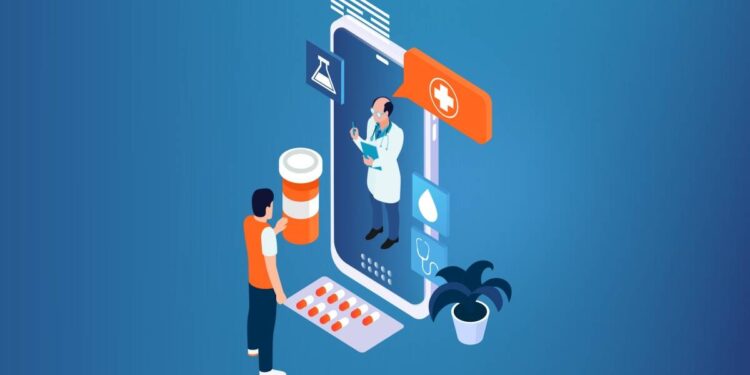 With the rising demand for mobile healthcare consultations, the future of the m-health market looks bright and full of opportunities
With the rising demand for mobile healthcare consultations, the future of the m-health market looks bright and full of opportunitiesBy Karan Chopra
Telemedicine is the next big opportunity in Indian healthcare. The advances in virtual visits and remote patient monitoring have improved access to quality care by removing traditional barriers such as mobility, distance, consumption of time and effort. Further, the pandemic has accelerated the shift to digital technology for communication, connection and virtual care. The providers have reported an overnight increase in demand for telemedicine during the pandemic and acceptance among consumers, doctors and paramedics, according to NITI Aayog report- Telemedicine: A Blessing in Disguise in Time of COVID-19.
Tele-health: Revolutionising Healthcare
With the rising demand for mobile healthcare consultations, the future of the m-health market looks bright and full of opportunities. According to Fortune Business Insights (2019-2026), the global m-health market is expected to grow at a CAGR of 29.1% from USD 34.28 billion in 2018 to USD 293.29 billion by the end of 2026. M-health is a broad sector comprising of connected medical devices, mobile services and apps. While connected medical devices and apps are enabling patients suffering from chronic diseases to self-monitor, services are receiving a positive response in the areas of personalised patient engagement, remote diagnosis and remote monitoring.
With the help of m-health technologies, an increasing number of people are now unlocking their potential to radically improve healthcare services even in the most resource-poor and remote environments. Though m-health is yet to reach an advanced stage, it is already on the path of revolutionising the healthcare system. This is because of some key benefits that it delivers – increased access and affordability of healthcare services, track and treat diseases, improved ability to diagnose and actionable public health information.
Further, healthcare facilities have begun to leverage healthcare data platforms to improve patient care coordination, reach more patients and triage them quickly. Moreover, the use of AI in diagnostic procedures, flow of information, data management of patients and radiology has dramatically transformed the way healthcare was perceived and delivered. Additionally, connected medical devices are being used to monitor various health parameters at home, providing easy healthcare access to patients and eliminating the need for hospital visits. By facilitating secure and swift information exchanges, remote patient monitoring allows care providers to determine whether hospital visits are necessary.
Preparing for the Tipping Point
As more and more healthtech companies continue to tap the advantages of m-health by introducing I-T enabled devices, providing remote patient care through telemedicine and imparting education to patients about chronic diseases, the m-health industry will grow at unprecedented levels and transform the traditional healthcare delivery system. It can be said that what began as a rescue from coronavirus, telehealth tools, are all set to eliminate the healthcare challenges facing the country for decades.
There are various dimensions that healthcare systems could consider as a part of broader strategic investment in virtual health. Innovation and cost structure are one of the most significant strategies – segmenting the patient populations and specialities to scale up the remote interactions with enabling home-based diagnostics and equipment; driving scaling decisions based on experience, quantified quality and financial measures, as compared with baseline measures for a physical encounter; and embedding virtual care settings within ambulatory and acute workflows to ensure a seamless experience for providers.
Further, healthcare systems could accelerate the development of a consumer-focused digital “front door” to help patients access their providers efficiently and ultimately enhance the customer experience. The value of this “front door” can be measured by quantifying clinical outcomes – access patient/provider satisfaction to drive advocacy.
What Began as a Convenience Service is Now an Inevitable Reality
The ultimate goal of telemedicine is to bring continuous care to patients without any delay or interruptions. One of the most important benefits of telehealth is its ability to lend health care in remote locations. Moreover, according to WHO, between 2000 and 2050, the number of people aged 60 years or older would likely increase from 605 million to 2 billion. The rapidly increasing elderly population have become significant beneficiaries of telehealth.
With a strategic approach; governments, NGOs and businesses can contribute tremendously to improve health outcomes on a massive scale. With many m-health projects being executed and industry leaders rapidly driving innovations, one thing is sure that the sector will serve an ever wider range of constituents in the years ahead. The next evolutionary stage in healthtech is to expand the scale and scope of operations.
Summing Up!
The equitable distribution of healthcare services has proven to be a major challenge in public health management and digital technology has the potential to deliver value in many areas of healthcare delivery. As telehealth continues to replace traditional health care, it will redefine the equity, quality, and affordability of healthcare throughout the world.
Further, with the increasing demand and need for telehealth services, it will continue to deliver benefits to both patients and medical specialists.
(The author is Founder of Hospido and co-founder of Doc on Call. Views expressed are personal and do not reflect the official position or policy of the Financial Express Online.)
Get live Stock Prices from BSE, NSE, US Market and latest NAV, portfolio of Mutual Funds, Check out latest IPO News, Best Performing IPOs, calculate your tax by Income Tax Calculator, know market’s Top Gainers, Top Losers & Best Equity Funds. Like us on Facebook and follow us on Twitter.
![]() Financial Express is now on Telegram. Click here to join our channel and stay updated with the latest Biz news and updates.
Financial Express is now on Telegram. Click here to join our channel and stay updated with the latest Biz news and updates.














